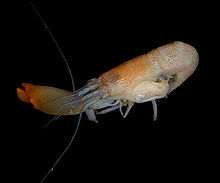Synalpheus
| Synalpheus | |
|---|---|
 |
|
| Synalpheus fritzmuelleri | |
| Scientific classification | |
| Kingdom: | Animalia |
| Phylum: | Arthropoda |
| Subphylum: | Crustacea |
| Class: | Malacostraca |
| Order: | Decapoda |
| Infraorder: | Caridea |
| Family: | Alpheidae |
| Genus: |
Synalpheus Spence Bate, 1888 |
| Type species | |
|
Synalpheus falcatus Spence Bate, 1888 |
|
| Species | |
|
More than 100, see text. |
|
| Synonyms | |
|
Zuzalpheus Ríos & Duffy, 2007 |
|
More than 100, see text.
Zuzalpheus Ríos & Duffy, 2007
Synalpheus is a genus of snapping shrimp of the family Alpheidae, presently containing more than 100 species; new ones are described on a regular basis, and the exact number even of described species is disputed.
The genus Zuzalpheus was established for S. gambarelloides, S. brooksi, and their closest relatives, which contain several notably eusocial species. While these do seem to form a clade, it is not fully resolved whether or not they are indeed the sister taxon of all the remaining Synalpheus.
However, a detailed cladistic study of morphological characters found well marked differences between the proposed two genera and concluded that the supposed species groups around S. biunguiculatus/S. coutierei, S. brevicarpus and S. neomeris are neither clearly defined nor, as it seems, monophyletic, while the group separated in Zuzalpheus was clearly distinct in characters of the minor first walking legs (pereiopods), and usually distinct in some others; in all Synalpheus sensu stricto checked to date, the transverse setal comb on the back of the minor first pereopod dactyl is missing, and the carpus is plump (about as wide as it is long or slightly wider) and small (not longer than half the length of the palm).
Moreover, their stylocerite clearly extends beyond the whole first segment of the first antennae, their scaphocerite blade is never missing, the fixed finger of the major first pereopod is about the same length as the dactyl and the uropodal exopod always has one tooth only; these traits however may be also present in some of the species separated in Zuzalpheus though as far as can be told, most of these differ. While the authors of the 2008 analysis made no explicit comment on the status of the newly proposed genus, they thus found the S. gambarelloides species group to be well-marked, and their results certainly harden the case for recognition of Zuzalpheus at least as a subgenus. However, this analysis only included 2 species from the S. gambarelloides species group, and none from the Caribbean, where the vast majority of the group resides. Opinion is still divided, however, and recently Zuzalpheus was synonymised with Synalpheus.
...
Wikipedia
